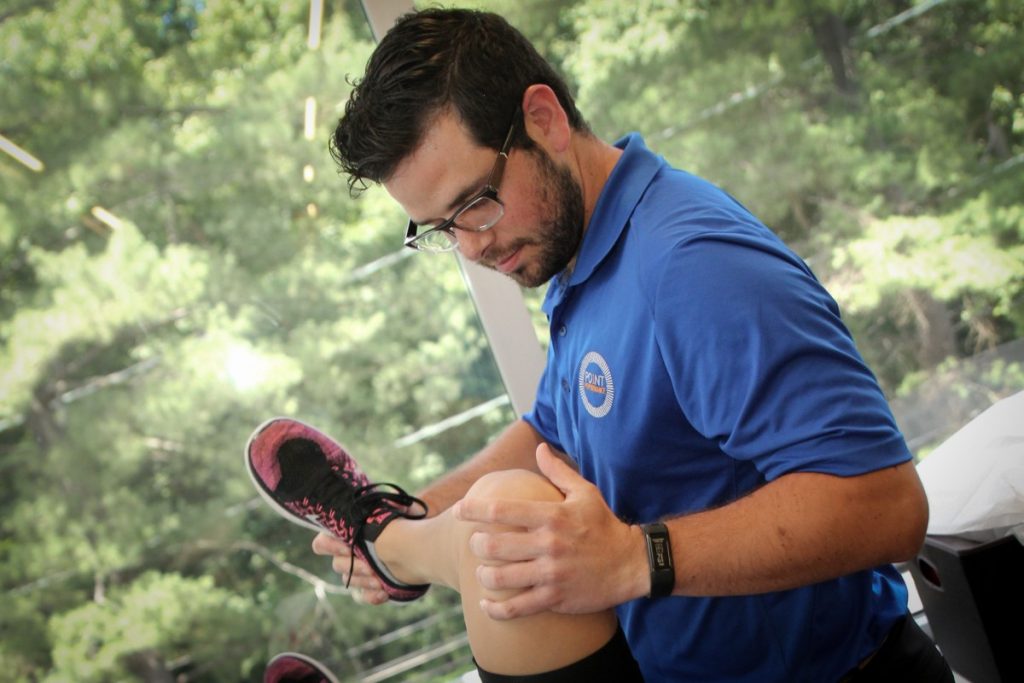
Knee Osteoarthritis of the knee is a chronic pain condition. It’s a progressive disease that is caused by inflammation and degeneration of the knee joint that worsens over time. If you find that your knees are regularly painful or swollen, are stiff first thing in the morning, or are making crackling noises, a possible cause could be osteoarthritis. According to the Arthritis Foundation, more than 27 million people in the U.S. have osteoarthritis, with the knee being one of the most commonly affected areas. Approximately 14 million people in the United States have symptomatic knee osteoarthritis. While it can occur in young people, the chance of developing osteoarthritis rises significantly after age 45. Women are more likely to have osteoarthritis than men. Approximately 60 percent of women over 55 experiencing osteoarthritis at some point.
What Is Knee Osteoarthritis?
Knee osteoarthritis is the most common form of arthritis in the knee. It is a progressive disease caused by inflammation and degeneration of the knee joint that worsens over time. It affects the entire joint including bones, cartilage, ligaments, muscles, and the synovium in the knee joint.
Recent evidence supports the notion of knee osteoarthritis as a “whole person condition” in which knee deterioration is influenced by a variety of factors, rather than solely based on damaged knee structures (British Journal of Sports Medicine). We now understand that knee osteoarthritis is influenced by each person’s particular context, including life stage, psychological, social, physical and lifestyle factors.
Several factors can increase the risk of developing arthritis, including:
- Age and gender.
- BMI.
- Heredity and bone structure.
- Muscular strength.
- Repetitive stress injuries.
- Activity level / athletics.
- Other illnesses and co-morbidities.
How Does Knee Osteoarthritis Feel?
Individuals who develop knee osteoarthritis may experience a wide range of symptoms and limitations based on the progression of the disease. Because the knee is a weight-bearing joint, your activity level, and the type and duration of your activities usually have a direct impact on your symptoms. Typically these symptoms do not occur suddenly or all at once, but instead develop gradually over time.
Symptoms of knee osteoarthritis may include:
- Worsening of pain during/after activity.
- Pain or stiffness after sitting for a prolonged period of time.
- A feeling of popping, cracking or grinding when moving the knee.
- Swelling and warmth following activity.
- Tenderness to touch along the knee joint.
How is Knee Osteoarthritis Diagnosed?
The diagnosis of knee osteoarthritis is based on two primary factors:
1) Your symptoms combined with a clinical exam
The diagnosis of knee osteoarthritis begins with a physical exam by your physician and/or physical therapist. A normal exam will include questions about your medical history, symptoms, your pain levels, activity levels, and possible family history of osteoarthritis. A physical exam should also be performed including your knee’s movement (range of motion), strength, mobility, and flexibility.
2) Diagnostic Imaging
X-ray
If knee osteoarthritis is suspected, your physician (physiatrist, orthopedist, or rheumatologist) will order X-rays of your knees to check the bones and cartilage of your knee joint. X-rays are used to confirm the diagnosis of knee osteoarthritis.
It is important to note that just because your x-rays show degenerative changes this does not necessarily mean you are destined to have knee pain. Imaging results are actually poorly related to pain. Findings on imaging, such as meniscal/cartilage tears, arthritic changes, and joint narrowing are common in people without pain, especially as we get older. Vice-versa: just because you have knee pain does not mean you have knee damage.
Other diagnostic tools:
Magnetic Resonance Imaging (MRI) scans may be ordered if more severe joint damage is suspected or to look more closely at the overall status of the joint and surrounding tissues.
Blood tests may also be ordered to rule out other conditions including those similar or related to knee osteoarthritis.
How is it Treated?
Managing chronic pain conditions like knee osteoarthritis is complex. Since there is no cure for osteoarthritis, the primary goals are to relieve the pain, limit its progression, and return function and mobility. All major clinical practice guidelines recommend education, exercise therapy, and weight control as the best first-line treatments to start with. Inappropriate pharmacological treatments, passive treatments, or surgery should not be recommended without adequately trialing education, exercise, and weight control. Understanding your relationship to pain is also important in order to manage your experience.
A typical treatment plan may include a combination of the following:
Physical therapy
Your physical therapist will consider the stage and extent of your knee osteoarthritis and prescribe an individualized exercise program to address your needs and maximize the function of your knee.
Specific exercises can help increase range of motion and flexibility, as well as help strengthen the muscles in your leg. Your physical therapist develops an individualized graded exercise program that meets your needs and lifestyle. PT treatment programs may include range-of-motion exercises, muscle strengthening and stretching, manual therapy, bracing, and activity recommendations.
Exercise therapy
As reported recently in Exercise and Knee Arthritis Pain, exercise has been proven to be the most effective treatment for early and moderate knee osteoarthritis. Strengthening the muscles around the knee makes the joint more stable and actually can decrease your pain. Stretching exercises help keep the knee joint mobile and flexible. Something as simple as walking regularly can help you manage osteoarthritis. And while it used to be believed that rest was beneficial, we now know that rest and avoidance makes the pain worse, and that the joint needs movement, even when painful.
Weight loss
Losing even a small amount of weight, if needed, can significantly decrease knee pain by reducing the stress on the knee joint.
Medications
Over-the-counter choices such as acetaminophen, ibuprofen, or naproxen sodium can potentially offer temporary relief.
Managing chronic pain conditions like knee osteoarthritis is challenging. In some situations, when dosed appropriately, medications are an appropriate part of medical treatment. Several types of drugs could be useful in treating knee osteoarthritis. However, with opioid abuse at unprecedented national levels, your doctor will work closely with you to determine the medications and dosages that are safe and effective for you.
Injections Therapies
Corticosteroids and hyaluronic acid, powerful anti-inflammatory agents, can be injected into the knee to provide short to medium term pain relief and reduce inflammation. Two other injection therapies are Platelet-Rich Plasma (PRP) and stem cells, which are demonstrating promising results in the regenerative medicine realm.
Modalities / Alternative therapies
Ice and heat can be used to help aid in pain management. Some alternative therapies that could be explored include topical creams, acupuncture, or supplements, such as tart cherry extract or turmeric with its anti-inflammatory properties.
Assistive devices
Using devices such as a cane, wearing shock-absorbing shoes or inserts, or wearing a brace or knee sleeve can potentially be helpful.
Surgery
There are many factors to consider when determining the appropriate surgical treatment for you, including the nature of your condition, your age, activity level, and overall health.
Joint replacement surgery is a cost-effective and beneficial treatment for the right person at the right time. When conservative treatments have been exhausted and/or your functional limitations and pain levels have reached a point where they significantly impact your daily life, joint replacement surgery can be a good option as a last resort. A small percentage of people may not get pain relief from joint replacement (up to 20 percent).
The meniscus (the shock absorber of the knee) may be involved in some cases of knee osteoarthritis. In the past, surgery (arthroscopy) to repair or remove parts or all of this cartilage was common. Current research however, has thoroughly shown that this is not as effective as we used to think beyond the short term, and may only lead to a speeding up of the arthritic process in the future.
Should you choose to have surgery, your physician and physical therapist can assist you prior to and following your surgery during your rehab.
